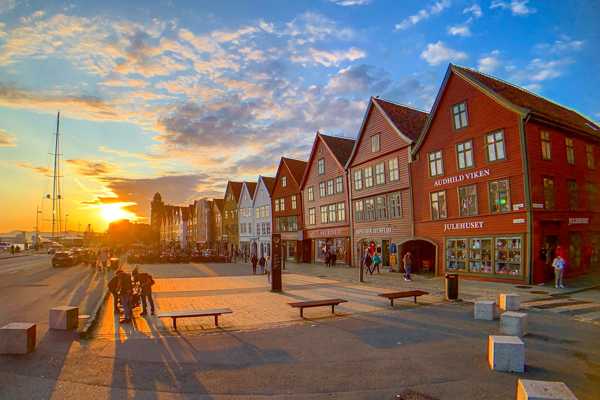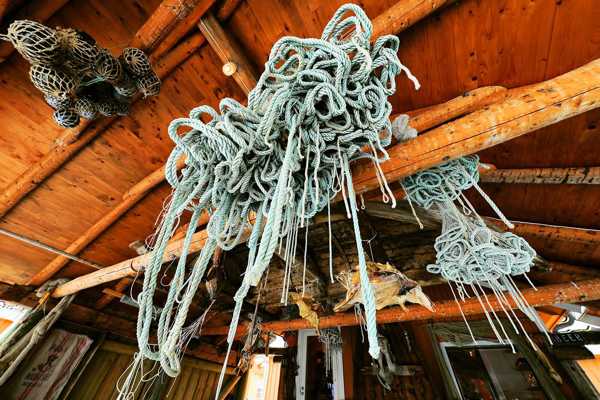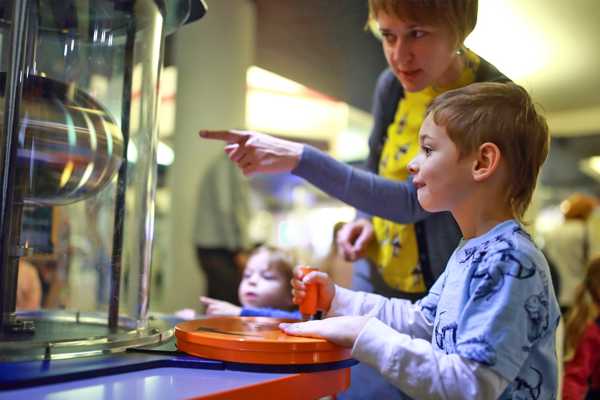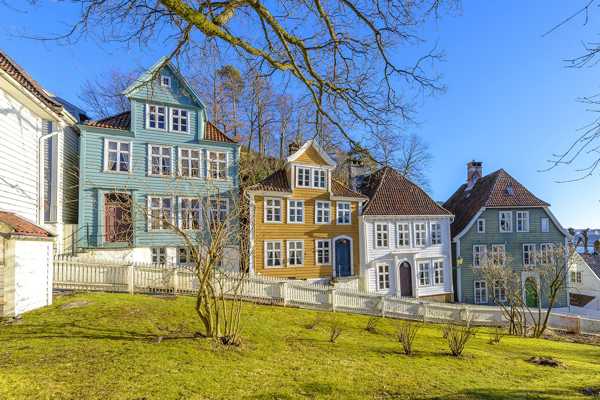Bergen's food culture is based on the fish trade, which created the wealth that the city is built on. This is where you'll find cod fresh from the sea, shellfish from the fjords, trout from the mountains and salmon from local fish farms. Bergen's history goes hand-in-hand with the fish trade, something you'll notice in the local menus.
Another regular feature of the western scenery is sheep, and mutton is widely used, both cured and fresh. And let's not forget those sweet treats. Perhaps it's the climate with its stormy weather, or perhaps it's the chapel culture. There's no doubt that stopping for a cosy cup of coffee is a very important part of the food culture in western Norway, and you always need something sweet to go with that coffee...- 1
Norwegian cinnamon buns
Plenty of sugar and cinnamon in the spirals

- Yemek
Spiral-shaped sweet pastries with sugar and cinnamon are standard fare in Northern Europe, but there's something special about the Bergen variety. It's been a while since the Hanseatics brought cinnamon buns to Bergen, and since then the people of Bergen have developed a bun that really stands out from the crowd for being generous.
Generous in size, generous amounts of sugar, and generous amounts of cinnamon in the spirals. And the dough must, of course, be fluffy and juicy, and without raisins, unlike further south in Europe. When it comes to the eating technique, there are two schools of thought: eat it like a normal bun, across the spirals, or roll out the spirals bit by bit, and bite off the end.
- 2
Prince fish
A noble cod dish

- Yemek
Few traditional dishes can be dated as accurately as prince fish, which was served for the first time on July 22, 1856, when the Swedish-Norwegian Crown Prince Carl visited Bergen together with the Dutch Crown Prince Wilhelm of Orange. The prince wanted cod for dinner, and the chefs had to find a convenient way to serve it for a large party.
Since then, this recipe has been associated with festivities and nobility. The dish itself is quite simple on paper, but requires a good sauce chef and cod fresh from the sea. The latter has never been in short supply in Bergen, a city built on the fish trade. Fresh cod in clean-cut portions is lightly salted and pulled for a few minutes, and served with a delicious cream sauce - a royal treat.
- 3
Raspeballer (komler)
Hearty Thursday dish

- Yemek
If you walk around the city on Thursdays, there's a good chance you'll see restaurants advertising raspeballer - or 'komler', as they are also called. The reason Thursday is raspeballer day is because Thursdays used to be a day of late trading, when shops stayed open longer.
Once you'd finished your shopping and had nothing left in your tummy - or purse - you needed some cheap, filling food. And that's how raspeballer - boiled potato dumplings - came about. There are local variations of this dish, but everyone agrees that raspeballer should be served with salted meat. In Bergen, they are also often served with Vossa sausage from the neighbouring village of Voss. Cabbage radish on the side and bacon on top is also common, and many people like a glass of sour milk to drink with it.
- 4
Braised lamb shank
Western lamb at its tastiest

- Yemek
Braised lamb shank is a dish that has developed as a result of the local supply of lamb. Sheep farming has strong traditions in the small farms on the steep western mountains. Norwegian sheep, especially Spælsaus, are hardy and easy-going. They spend much of their time in the wild and graze and enjoy themselves in the mountains. This not only makes for high animal welfare, but also top quality lamb, especially during the slaughter season in the autumn.
And Bergen knows how to honour this tradition. In large parts of Norway, the main Christmas meal is mutton. Many think that the shank is the tastiest part of the lamb. By roasting it in a sealed pot in the oven, i.e. braising it, you preserve as much of the flavour and tenderness as possible, while the spice penetrates well into the meat. This is the real taste of Western Norway, with influences from the continent.
- 5
Bøkling
Smoked herring snacks

- Yemek
Smoked herring is known as 'bøkling'. Smoking is a traditional way of preserving fish, and on every fish counter in Bergen you'll find salmon, mackerel and herring that have been treated in this way. Bøkling used to be a seasonal product, but in the age of cold storage, it is now available all year round.
Nevertheless, it's best when made from herring fresh from the sea, so in the winter and during a short period in the summer. Today the bøkling is nearly always sold without head, tail or bones, so you can eat it as it is, without further preparation needed. Bøklilng doesn't require many side dishes. A slice of wholemeal bread or a boiled potato and a little sour cream goes a long way.
- 6
Mountain trout
Fresh mountain fish

- Yemek
Many settlements have active hunters' and fishermen's associations that ensure that local mountain lakes have a good population of trout. If you bring a fishing rod to the mountains, there's a good chance you'll be able to catch your own dinner.
If this is not possible, it's worth keeping your eyes peeled if you're driving along the country roads in the Bergen area.In many places there's not far from the trout lake to the kitchen, and crispy mountain laurel is a regular feature on the menu at small local cafés, especially in the summer months.
- 7
Crayfish
Delicacy from the fjord bed

- Yemek
Crayfish is a close relation of lobster. It's much smaller, but just as tasty. It is found throughout the Northeast Atlantic, but thrives particularly well in the western fjords, hence the 'norvegicus' in its Latin name. Few places in the world have better access to freshly caught crayfish than the coastal town of Bergen.
For many years they weren't considered particularly attractive, but interest in the fish has risen sharply and it is now considered a delicacy with a kilo price of several hundred kroner. Many prefer crayfish to lobster. If you buy pre-cooked crayfish from the fish counter, check for a good bounce in the tail - then you know it's freshly cooked and of top quality.
- 8
Stockfish
The fish that made Bergen

- Yemek
Stockfish was Norway's first major export item, and the monopoly on trade of stockfish from northern Norway made Bergen a trading town of European standard. This is reflected in the Hanseatic coat of arms that adorns Bergen's Hansa beer, one half of which is a crowned stockfish. The Christmas dish of lutefisk is probably the most famous stockfish dish. It consists of stockfish that is soaked and leached so that it has a jelly-like consistency.
The lutefisk taste is distinctive but doesn't have a particularly strong flavour, which is why many prefer to mix it with foods such as crispy bacon and pea stew. Lutefisk is extremely uncultivated, and large amounts of it are put on lutefisk tables at Christmas time. Stockfish is also eaten as a snack in the form of small flakes, which are sold at some fishmongers in Bergen.
- 9
Krotekake
Favourite coffee treat in Hardanger

- Yemek
Krotekaker is a lefse-like cake with a pattern ("kroter") that can be baked in large quantities and stored in a dried state. Before serving, it is soaked and softened, usually with butter and sugar. Krotekake is usually eaten with your afternoon coffee in Hardanger.
As Bergen absorbs food traditions from the surrounding districts, so krotekaker has become a popular addition to the city's cake platters and patisseries. The best can be found on market day when bakers from the krotekaken home district sell their goods in the square. You have to be quick, because they tend to go in a flash.
- 10
Pinnekjøtt - ribs
Bergen's traditional Christmas dinner

- Yemek
The story of 'pinnekjøt' often begins like this: In all the mountains in Western Norway, sheep graze on summer pastures. In autumn they are sent to the slaughterhouse. After cutting, most cuts of lamb and sheep go to salting, maturing and drying, possibly also smoking. A few months later, these are ready for consumption - just in time for Christmas. By then, the meat has developed a special aroma and consistency, and the distinctive aroma of freshly steamed ribs is the very smell of Christmas Eve for people from Bergen.
Traditional side dishes are kohlrabi purée, gravy and potatoes, and perhaps also Vossa sausage. This is a strong, salty dish with a full-bodied taste, best washed down with an aromatic red wine or refreshing beer or just a glass of water. This is a festive dish however you serve it, and a regular feature on the menus of Bergen's restaurants in December.

















